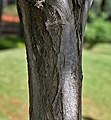Cordia sebestena
Cordia sebestena | |
|---|---|
 | |
| Scarlet cordia flowers | |
Scientific classification | |
| Kingdom: | Plantae |
Clade: | Angiosperms |
Clade: | Eudicots |
Clade: | Asterids |
| Order: | Boraginales |
| Family: | Boraginaceae |
| Genus: | Cordia |
| Species: | C. sebestena |
Binomial name | |
Cordia sebestena L.[1] | |
Cordia sebestena is a shrubby tree in the borage family, Boraginaceae, native to the American tropics. It ranges from southern Florida in the United States and the Bahamas, southwards throughout Central America and the Greater Antilles.[1] Common names have included siricote or kopté (Mayan) in 19th Century northern Yucatán,[2]scarlet cordia in Jamaica,[3] and Geiger tree (after Key West wrecker John Geiger) in Florida.[4]
Contents
1 Description
2 Cultivation
3 Gallery
4 References
5 External links
Description
Cordia sebestena grows to a maximum height of 25–30 feet at maturity, with a nearly equal spread. The crown is round to vase-shaped. Branches tend to be somewhat drooping, and the tree is naturally multitrunked. When only a single trunk is allowed to develop, it can attain a diameter of 12 inches.[5]
The dense, evergreen foliage consists of dark green, leathery, alternate, ovate leaves, seven inches long, with wavy margins. These leaves are covered with small hairs, lending them a rough, "sandpapery" texture.[5]
Flowers are produced in clusters at branch ends throughout the year, particularly in the spring and summer. They are dark orange in color, tubular and flaring (salverform) to a width of two inches. Pear-shaped fruits follow the flowers, averaging two inches in length. Fruits are fragrant and edible, but not flavorful.[5]
Cultivation
Cordia sebestena is widely planted throughout the tropics as an ornamental plant in gardens for its showy flowers. It is a slow-growing plant, and sheds enough leaves and fruit to require some upkeep. The wood is rather light in density, but branches are not prone to breakage.The tree should be pruned in its youth to establish a structure, as it is prone to low branching. Soil tolerance is fairly broad, provided the soil drains well. Cordia sebestena tolerates drought, but not frost. It is not particularly susceptible to pests and diseases, other than the geiger tortoise beetle,[5] which can cause occasional defoliation. This plant tolerates salt spray found near the ocean. It enjoys full sun, and can grow in a part-day sun situation as well. Its uses include: street tree, shade tree, even as a container subject in its youth. It is planted in traffic medians and parking lots, and is a useful seaside subject.[5]
Gallery

Buds of Scarlet cordia

Leaves and flowers

Trunk of Cordia sebestena

Branches and flowers

Leaves and flower buds

A Geiger tree, at Geiger's house in Key West, Florida

Tree (Hyderabad, India)

Flower buds (Hyderabad, India)

Flowers & leaves (Hyderabad, India)

Close-up of flower (Dakar, Senegal)

Fruits (Hyderabad, India)

Fallen fruit (Hyderabad, India)

Leaves, underside (Hyderabad, India)

Trunk (Hyderabad, India)
References
^ ab "Cordia sebestena". Germplasm Resources Information Network (GRIN). Agricultural Research Service (ARS), United States Department of Agriculture (USDA). Retrieved 2013-02-25..mw-parser-output cite.citation{font-style:inherit}.mw-parser-output q{quotes:"""""""'""'"}.mw-parser-output code.cs1-code{color:inherit;background:inherit;border:inherit;padding:inherit}.mw-parser-output .cs1-lock-free a{background:url("//upload.wikimedia.org/wikipedia/commons/thumb/6/65/Lock-green.svg/9px-Lock-green.svg.png")no-repeat;background-position:right .1em center}.mw-parser-output .cs1-lock-limited a,.mw-parser-output .cs1-lock-registration a{background:url("//upload.wikimedia.org/wikipedia/commons/thumb/d/d6/Lock-gray-alt-2.svg/9px-Lock-gray-alt-2.svg.png")no-repeat;background-position:right .1em center}.mw-parser-output .cs1-lock-subscription a{background:url("//upload.wikimedia.org/wikipedia/commons/thumb/a/aa/Lock-red-alt-2.svg/9px-Lock-red-alt-2.svg.png")no-repeat;background-position:right .1em center}.mw-parser-output .cs1-subscription,.mw-parser-output .cs1-registration{color:#555}.mw-parser-output .cs1-subscription span,.mw-parser-output .cs1-registration span{border-bottom:1px dotted;cursor:help}.mw-parser-output .cs1-hidden-error{display:none;font-size:100%}.mw-parser-output .cs1-visible-error{font-size:100%}.mw-parser-output .cs1-subscription,.mw-parser-output .cs1-registration,.mw-parser-output .cs1-format{font-size:95%}.mw-parser-output .cs1-kern-left,.mw-parser-output .cs1-kern-wl-left{padding-left:0.2em}.mw-parser-output .cs1-kern-right,.mw-parser-output .cs1-kern-wl-right{padding-right:0.2em}
^ Heilprin, Angelo (July–December 1891). "Observations on the flora of North Yucatan". Proceedings of the American Philosophical Society. 29 (136): 137–44.
^ "Bats Of Jamaica". Museum, University of Nebraska State. Retrieved 2011-06-20.
^ Nelson, Gil (1996). The Shrubs and Woody Vines of Florida: a Reference and Field Guide. Pineapple Press Inc. p. 63. ISBN 978-1-56164-110-9.
^ abcde Gilman, Edward F. "Cordia sebestena: Geiger Tree". University of Florida Institute of Food and Agricultural Sciences Extension. Retrieved 9 February 2017.
- USDA plant Classification Cordia sebestena
External links
![]() Media related to Cordia sebestena at Wikimedia Commons
Media related to Cordia sebestena at Wikimedia Commons
![]() Data related to Cordia sebestena at Wikispecies
Data related to Cordia sebestena at Wikispecies
This Asterid article is a stub. You can help Wikipedia by expanding it. |















Comments
Post a Comment